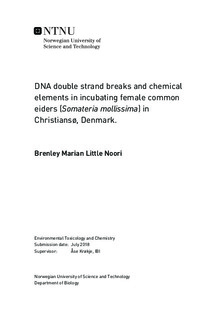DNA double strand breaks and chemical elements in incubating female common eiders (Somateria mollissima) in Christiansø, Denmark.
Master thesis
Permanent lenke
http://hdl.handle.net/11250/2565569Utgivelsesdato
2018Metadata
Vis full innførselSamlinger
- Institutt for biologi [2611]
Sammendrag
Genotoxic agents are ubiquitous in the Baltic Sea and may cause effects not only at amolecular level but at an individual and population level as well. Fasting during reproductionmay lead to a state of oxidative stress and enhance the genotoxicity of nonessentialelements due to low levels of essential elements and nutrients. Thereforegenotoxic agents pose a threat to fasting species. The present study aimed to assessDNA double strand breaks (DNA DSBs) in relation to body mass and non-essential elementsin blood of female common eiders (Somateria mollissima) in the Southern BalticSea (Christiansø, Denmark) at the beginning (day 5) and end (day 25) of incubation.Furthermore, the present study aimed to investigate the relationships between nonessentialand essential elements in whole blood of female common eiders (Somateriamollissima) on day 5 and day 25 of incubation. This was a unique study because eachincubating eider was sampled twice and therefore acted as its own control. The presentstudy analyzed DNA DSBs using gel electrophoresis to quantify DNA-fraction, of totalDNA, that migrated into the gel (DNA-FTM).During incubation DNA-FTM increased significantly throughout incubation (0.4 -70 %). Body mass decreased significantly (17 - 44 %) throughout incubation. Significantlyincreasing levels of Cd were associated with decreasing levels of Ca and Zn andincreasing levels of Cu, which may demonstrate an increase in absorption of Cd fromday 5 to day 25 of incubation. While significantly increasing levels of Pb were significantlycorrelated with decreasing levels of Ca, which may indicate Pb was released frommedullary bone during incubation. As and Hg were not found to significantly increase.Hg was found to be positively and significantly correlated with Se, suggesting a protectiveeffect of Se on Hg.DNA-FTM was found to be negatively and significantly correlated to body mass andpositively correlated to Hg (not significantly). Given the high levels of DNA DSBs in thecurrent study compared to previous studies in Baltic Sea eiders, there may be other factorsat play, apart from non-essential elements, causing DNA DSBs. However, the highlevels ofDNA DSBs and body mass loss may reflect the overall health of this endangeredpopulation, which is exposed to multiple stressors.
